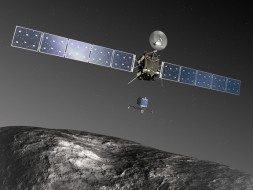As the Rosetta spacecraft approaches its objective, Comet 67P/Churyumov-Gerasimenko, astronomers are getting a better view of the nucleus — and it's stranger than anyone suspected.
The Rosetta spacecraft is closing in on Comet 67P/Churyumov-Gerasimenko, providing astronomers with an ever more detailed view of its structure. Judging by the latest photos, Comet C-G actually has two components in the shape of a rubber ducky.

ESA / C. Carreau / ATG medialab
After traveling 10 years and 6 billion kilometers to reach the comet, Rosetta is set to meet up with its target this August. Over the next two years, the spacecraft will conduct the most in-depth study of a comet ever attempted, using both a close-orbiting spacecraft and the hitchhiking Philae lander, which is to touch down on the comet’s surface in November.
But as Rosetta approaches Comet C-G, photos taken with its OSIRIS imaging system are revealing that the comet’s shape is stranger than anyone anticipated. In a press release earlier this month, OSIRIS Principle Investigator Holger Sierks (Max Planck Institute for Solar System Research) stated that the comet’s nucleus is an “irregularly looking body.” Images of the comet taken on July 4th from a distance of 37,000 km show three distinct structures on the nucleus, though this is not unexpected. Images taken in 2003 by the Hubble Space Telescope show many irregularities, and the five comets previously visited by spacecraft are hardly spherical.
Images taken July 14th indicate that the nucleus of Comet Churyumov-Gerasimenko is a contact binary, made up of two smaller components. Taken a mere 12,000 km from the comet (about the distance from Germany to Hawaii, Sierks notes), the views clearly show two distinct pieces: one fairly round, the other elongated. The whole nucleus appears to span 3½ by 4 km (about 2 by 2½ miles), which matches up with prior observations by the Hubble and Spitzer space telescopes.

ESA/Rosetta/MPS for OSIRIS Team
While Comet C-G’s binary structure is not uncommon, it is more extreme than astronomers expected, says Joel Parker (Southwest Research Institute). The scientific community is bubbling with interest about the comet’s weird morphology, and some have already dubbed the nucleus a “rubber ducky.”
The formation mechanism of contact binaries is still a topic of debate. One theory is that two comets melded together in a low-velocity collision during the solar system’s formation. If Comet C-G came together this way, its pieces would have only made contact at about 3 meters per second. Another possibility is that a single comet was sculpted into a peculiar shape by the gravitational tug of a massive object, like the Sun or Jupiter. Or perhaps the nucleus was once a much rounder object that only became asymmetric once a substantial amount of its ice evaporated. Astronomers hope that Rosetta’s detailed study might finally shed some light on the origin of these strangely shaped bodies.
Amid all this speculation, mission manager Fred Jansen (European Space Agency), urges caution. “We currently see images that suggest a rather complex cometary shape, but there is still a lot that we need to learn before jumping to conclusions,” he stated in the Rosetta blog. The team is looking forward to obtaining better three-dimensional views of the nucleus as the spacecraft approaches.
Scientific speculation aside, the comet’s unexpected shape might require Rosetta scientists and engineers to tweak their plans for the rendezvous in August. “We will need to perform detailed analyses and modeling of the shape of the comet to determine how best we can fly around such a uniquely shaped body,” Jansen said. Moreover, maneuvering the Philae probe in such an unusual gravitational field and selecting a landing site will prove trickier than anticipated, explains Parker.
Read a full account of Rosetta's impending approach to Comet 67P/Churyumov-Gerasimenko in the August issue of Sky & Telescope.
 4
4









Comments
Anthony Barreiro
July 17, 2014 at 7:03 pm
We could call one half Churyumov and the other Gerasimenko.
You must be logged in to post a comment.
robert-simpson
July 19, 2014 at 10:50 am
Paragraph 3 line 4 should be "Principal".
You must be logged in to post a comment.
Justin S
July 22, 2014 at 9:45 am
I hope we can get some higher resolution pictures soon!
You must be logged in to post a comment.
Villagerjjm
July 28, 2014 at 9:44 pm
I agree with Justin.....Where are the clear photos?
You must be logged in to post a comment.
You must be logged in to post a comment.